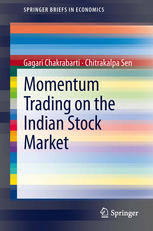موضوعات
آموزش و پرورش
ادبیات و زبان
پزشکی، دندانپزشکی و داروسازی
تاریخ و جغرافیا
داستان و رمان
دیگر
دین و فلسفه
روانشناسی
ریاضیات و آمار
سلامتی، تناسب اندام و رژیم غذایی
شیمی و پلیمر
علوم اجتماعی و حقوق
علوم زیستی و بیوتکنولوژی
فیزیک و نجوم
کامپیوتر و اینترنت
کتابهای کودکان و داستان
کسب و کار و اقتصاد
کشاورزی و دامپزشکی و غذا
معماری
مهندسی و فناوری
هنر و تئاتر
محصولات
Gagari Chakrabarti, Chitrakalpa Sen (auth.) - Original PDF
نویسندگان: خلاصه: This study is an exploration of the Indian stock market, focusing on the possible presence of momentum trading. One thing, however, should be noted. While it is true that momentum trading, which tends to generate speculative bubbles, may result in a financial market crash, its nature in contrast might depend on the nature of the economy itself. The study, while exploring the presence and nature of momentum trading on the Indian stock market in recent years, seeks to relate it to significant structural breaks in the Indian or global economy. To be precise, it outlines a potential correlation between the instability in the stock market and the speculative trading on the market, exploring the question of whether it is human psychology that drives financial markets. In the process, the choice of a significant structural break has been obvious: the global financial meltdown of 2007-2008 – a crisis that has often been referred to as the worst ever since the crash of 1929. While analyzing the nature of momentum trading on the Indian stock market with regard to the financial crisis of 2007-08, the study takes into account two major representatives of the market, the BSE (Bombay Stock Index) and NSE (National Stock Index), for the period 2005 to 2012. This study seeks to answer a few important questions. First of all, it tries to unveil the underlying structure of the market. In doing so, it examines the following issues: (i) What was the latent structure of the Indian stock market leading up to the crisis of 2007-08? Does the structure offer insights into designing profitable trading strategies? (ii) Is it possible to construct a profitable portfolio on the Indian stock market? (iii) Is there any profitable trading strategy on the Indian stock market? While exploring these issues, the study delves deeper, breaking the whole period down into two sub-periods, before the crisis of 2008 and after the crisis. The purpose of this division is to determine whether there has been any discernible change in the market structure since the shock.آیا کتاب مورد نظر هنوز بر روی سایت قرار نگرفته است؟ جای نگرانی نیست! کافی است بر روی گزینه سفارش کتاب کلیک کرده و درخواست خود را ثبت کنید. در کمتر از چند ساعت کتاب شما را آماده خواهیم کرد.
